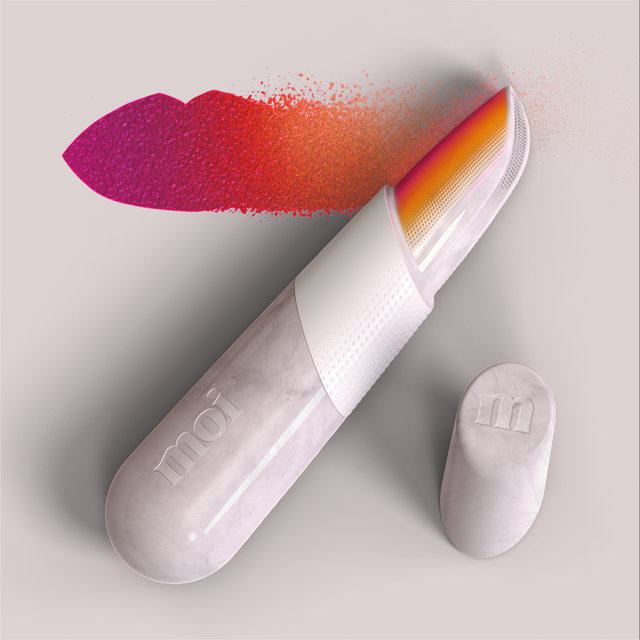COULD SUSTAINABLE DIGITAL LIPSTICKS BECOME A REALITY?
BEAUTY 4.0

The steady rise in consumption over the past seventy years has culminated in a culture of fast disposability where the products and packaging we buy are used and discarded without much thought as to the consequences.
The beauty industry alone produces 120 billion units of packaging per year according to Zero Waste Europe. How much of this is recycled is unclear. We do know that a significant portion of this is plastic. The first global analysis of all mass-produced plastic ever manufactured concluded that only 9% of plastic was actually recycled and a whopping 79% ended up in landfill or the natural environment.
Thankfully we are in a time of unprecedented change…
Although climate change threatens our very existence, it is driving the demand for more responsible approaches to how we live our lives. Consumers are displaying new attitudes, behaviours and expectations causing our relationship with brands to constantly evolve. According to David Galbraith in his article Our world in flow change, we are witnessing something as profound as the shift from agricultural to industrial society.
The core driver of this change is technology. We are in the midst of what is commonly referred to as the 4th Industrial Revolution, and the convergence of the physical world with the virtual world through the deployment of the twin digital and ICT (information and communications technology) technologies.
For Fast Moving Consumer Goods (FMCG) companies, this will mean radical transformation the likes of which has not been seen before. Packaging in particular will be disrupted and reimagined in a new light that will challenge the very semantics of the name. Here at 1HQ, we call this packaging’s Fourth Age.
The impact of this transformation on the beauty industry is most notable in the emergence of technology-empowered personalisation and a feedback loop of consumer analysis and tailored products. Yet lipstick, a powerful tool of expression for thousands of years, has remained largely the same since the invention of the tube pack we know today.
Taking inspiration from Industry 4.0, 1HQ has created Moi: a smart, adaptable and reusable lipstick solution for the near future based upon the advances in ink jet printing.
INTRODUCTION

It no longer makes sense for us to produce a product whose packaging is discarded after a single use. Lush estimates that almost one billion lipstick casings are discarded each year, so creating reuse systems that reduce packaging waste and achieve a more circular approach is critical to shaping a sustainable future.
Moi is a connected refillable applicator that will be treasured and used over and over, leading to the removal of packaging and product waste, revolutionising the eco-credentials of this typically single-use product. Built-in reservoirs containing the constituent ‘ink’ formulation mixers are simply refilled through autonomous filling stations located in department stores and at busy locations.
The body of Moi is 3D printed in recyclable materials such as ceramic and metal, with any unwanted applicators recycled back into the system. This means there is no material loss: the system is circular as waste has been designed out. And for when the body does reach the end of its useful life, additive manufacture can use the shredded materials as feedstock so the loop can be closed.
SYSTEMISED SUSTAINABILITY
MIKE WEBSTER
1HQ | United Kingdom

Bio...
Mike Webster is an award-winning industrial designer with a wealth of knowledge and expertise in design and innovation across FMCG, consumer electronics, retail and transportation. He is director of 3D & Experience at design agency 1HQ. The team fuses brand and industrial design expertise to bring brands to life through physical products and packaging, create compelling consumer experiences and shape sustainable futures.

The biggest opportunity for sustainable innovation lies not just in making or using less, but in creating more desire. The benefits of reuse are therefore not solely focused on sustainability; it is the future of how consumers will experience packaging.
Imagine a lipstick that can be any colour at any time, even change colour as it is being applied… thanks to the cutting-edge ink jet printing technology Moi prints an infinite range of colours and effects directly onto users’ lips. This could be to complement users’ skin tones or their latest online shopping haul, a celebrity endorsed colour palate, or a fabric sample loved and perfectly matched. Furthermore, unique effects including fades, gradients and patterns are now easy to accurately apply without the need for makeup artists. Moi doesn’t just give users flawless colour; it offers a number of preparatory and post-application benefits too such as primers and finishes.
Applying lipstick is a ritualised experience, so Moi retains the current product semantics and application ergonomics. Beyond that, the interaction offered is more akin to a consumer electronic product.
Moi is turned on and ready to use as soon as the cap is opened, and like many other smart devices, can be controlled through a combination of haptic and voice input. So, whether users are after a striking matte red or a subtle nude, they are able to select the right option by simply applying pressure or speaking. The sides of the Digital Tip light up to visualise the choice of colour and effect.
Users are forever seeking help to simplify their daily routine. With Moi the days of intricate lipstick application in front of a mirror are over. Proximity sensors enable accurate application with crisp edges and the style to be manipulated, such as fuller lips.
REUSE IS THE FUTURE OF EXPERIENCE
Mass production has served us well for decades but its inflexibility to adapt quickly to the changing needs of markets and consumers means it is no longer fit for purpose. Instead, we will see the transition from specialisation - making the same thing over and over - to mass customisation through flexible additive manufacturing.
Enabled by banks of connected 3D printers controlled by AI, blockchain and autonomous robots, Moi is customisable on the production line to allow users to create their own specification from a range of applicator materials such as metals, ceramics and recyclable resins.
MASS CUSTOMISATION
This is only the beginning.
The true potential of digital technology has yet to be realised. This technological revolution is following the same evolutionary pattern as those that preceded it according to the technological economist Carlota Peres.
“In the history of technological revolutions, there is a moment in each revolutionary surge of development when the wild period of Schumpeterian creative destruction has collapsed, and the future promised by the new technologies looks both uncertain and threatening. We are at this juncture today.”
The age of smart and sustainable beauty is coming!



